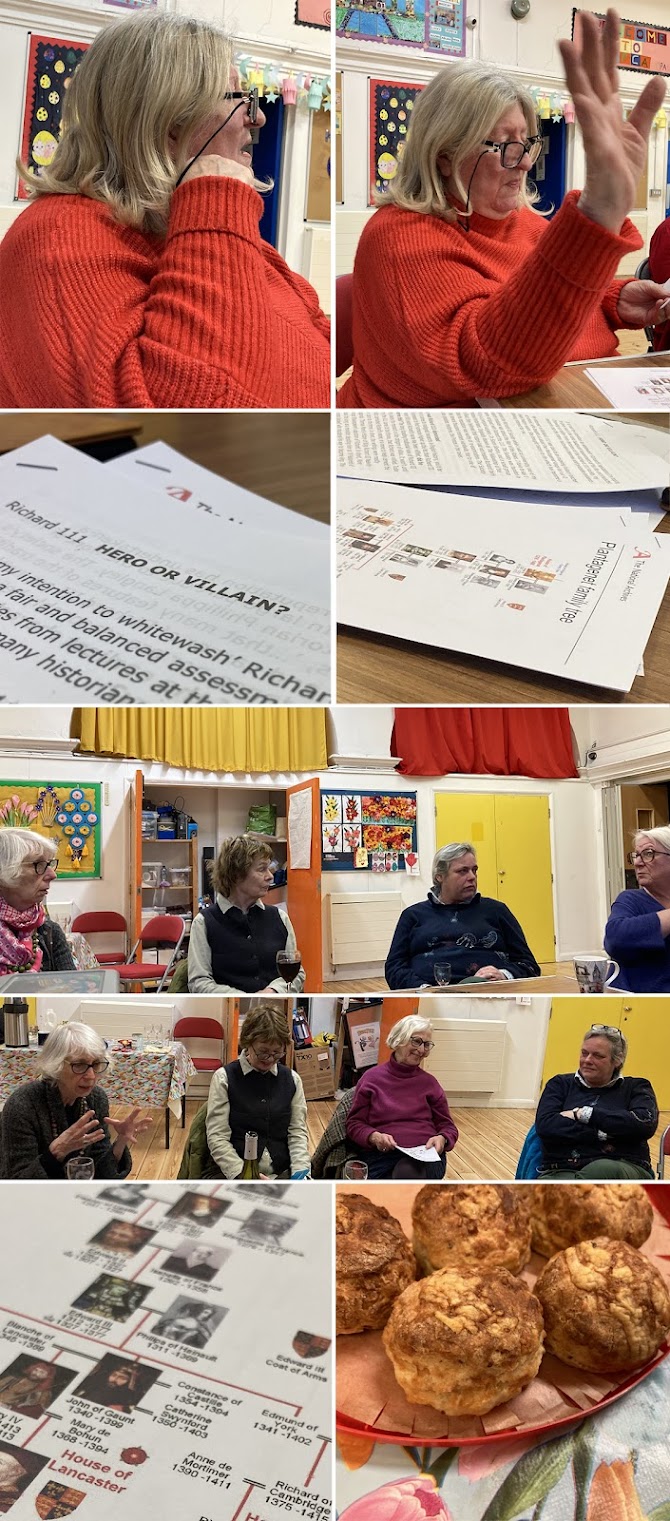This month, in a round-table talk with discussion, our very own Celya set out the case for a fair and balanced history of Richard III, a much-vilified king.
His story has fascinated Celya since she was at school, studying the Plantagenets for O level with an inspiring history teacher (all of the class passed, with very high grades). Then, as a history student at university, she joined the Richard III Society.
Celya explained that the picture we have of Richard III comes from Shakespeare, performances such as Olivier's and the writings of Thomas More, all rooted in the times of Henry VII and the story of the Princes in the Tower.
The work of Phillipa Langley has uncovered a lot more, over several books and a Channel 4 documentary, based on the Missing Princes Project, where Rob Rinder is asked to authenticate the documents found.
So was Richard III the victim of the earliest character assassination in British history?
Celya took us through the six major crimes Shakespeare accuses him of, four of which have since been challenged, including deaths not proven, a marriage declared bigamous, a murder more likely to be from natural causes and new evidence on what could have happened to the Princes in the Tower.
Were the Princes killed by order of Richard III? We don't know. They were in the Tower for four months, not uncommon at the time, when it was a palace and traditional for future Kings to reside there before a coronation. Then they disappeared. The evidence does not support the Princes' murder.
There were bids for power, claims of impostors, various national interests, counterclaims...
Philippa Langley has won an award for her work finding the remains of Richard III through her Looking for Richard project. She had been convinced that the grave had not been destroyed in the Dissolution of the Monasteries. Much was made at the time of the discovery that they were in a car park – but the car park was the site of a former palace. The University of Leicester declared in 2013 that it was beyond reasonable doubt that the remains were those of Richard III.
Richard III's Tudor enemies had taken not just his life, at the Battle of Bosworth, but his whereabouts. And Celya noted that the more people thought he was a tyrant, the less chance there was of finding him.
Examination of the skeleton found the right date, description, mitochondrial DNA and evidence of Scoleosis, with curvature of the spine less pronounced than our modern image of him suggests. He was probably killed by a blow to the head from a large bladed weapon.
He had a son, Edward, with Anne Neville, and history is vague about what happened to him. Little is known of his life. He was made nominal Lord Lieutenant, then Prince of Wales, declared heir apparent in 1484 – and died in the same year. Where he is buried is unclear. But had Bosworth not happened, he might have had a right to the throne.
Before the Tudors' take on things, Richard III was a popular king. His list of achievements included laws extending bail; making it legal to seize property only until someone was accused; stopping occasional courts from abusing their power by convicting people to whom they bore ill will; stopping concealment of rival titles; addressing child heirs; and the raising of revenue due to the benevolence of false gifts. Were those, Celya argued, the actions of a tyrant?
Why so much interest in a king who was on the throne for so short a time? The Richard III Society, founded in the 1920s, has a substantial global membership of 'Ricardians', historians and lecturers keen for us to revise our view and people who love the villainous side of the story.
And what was the appeal in Shakespeare's play? We reminded ourselves that he was a popular playwright of the time – perhaps the draw was people's love of a good story and the attitudes of the time towards disability?
We discussed historical societies generally, context, the chronology of names and how these stories come up, through big names and new scientific means of investigating objects.
But the question that stumped us was where the word 'Plantagenet' originally came from. We might need another of Heather's marvellous cheese scones while we look that up...
A huge thank-you to Celya for her rigorous research and fascinating family tree printouts.
Our April coffee morning: Friday 26th April, meet between 10.30am and 11am for Coffee, chat and adorable artworks in Canary Wharf. Meet at the café upstairs in Waitrose at Canary Wharf
At the March coffee morning the arrival of the latest decorated animal sculptures in support of Guide Dogs for the Blind was mentioned. These charming pieces are dotted about Canary Wharf, and it was suggested that we combine coffee with an uplifting search to find some (or all) of these lovely creatures. So, unusually, we will be meeting at an in-store café, as a convenient starting spot for those curious to explore the trail. If you'd like to download the trail guide, you can find it here.


No comments:
Post a Comment